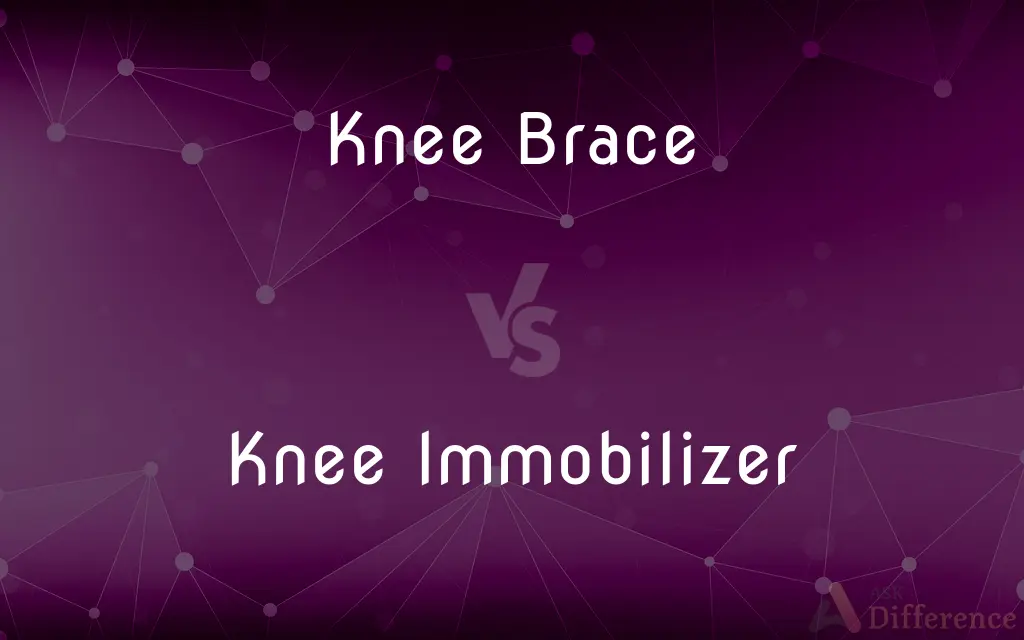Knee Brace vs. Knee Immobilizer — What's the Difference?
By Tayyaba Rehman & Fiza Rafique — Published on April 1, 2024
A knee brace supports and stabilizes the knee during movement, while a knee immobilizer restricts knee motion to facilitate healing after injury or surgery.

Difference Between Knee Brace and Knee Immobilizer
Table of Contents
ADVERTISEMENT
Key Differences
Knee braces are designed to provide support, stability, and sometimes pain relief to the knee joint during activities. They come in various types, including prophylactic braces, functional braces, and rehabilitative braces, each serving different purposes such as preventing injuries, providing support post-injury, or aiding in rehabilitation after surgery.
Knee immobilizers, on the other hand, are used to keep the knee in a fixed position. They are typically used immediately after surgery or a significant injury to prevent movement of the knee joint, thus aiding in the healing process.
Knee braces allow for a certain degree of movement, while they can be adjusted for tightness and support depending on the individual's needs and the specific knee issue. They are often used by athletes, individuals with chronic knee problems, or those recovering from minor knee surgeries. Knee immobilizers are more restrictive and are usually fully padded, with rigid supports on the sides and sometimes the back, to completely immobilize the knee.
The use of a knee brace is often part of an ongoing knee care or recovery plan, which may include physical therapy and exercise. They are designed to be worn during activity to reduce the risk of further injury and to support the knee's natural movement. Conversely, knee immobilizers are generally recommended for short-term use during the initial healing phase following an acute injury or surgery, where movement could hinder recovery.
Selecting between a knee brace and a knee immobilizer depends on the specific knee issue, the phase of injury or recovery, and the advice of a healthcare professional. While knee braces are more about support and prevention, knee immobilizers focus on healing and protection by restricting movement.
ADVERTISEMENT
Understanding the differences between these devices is crucial for individuals dealing with knee issues. Proper use of a knee brace or immobilizer, under the guidance of a healthcare provider, can significantly impact the healing process and the overall health of the knee.
Comparison Chart
Purpose
Supports and stabilizes the knee during activity
Restricts knee motion to aid healing
Movement
Allows for controlled movement
Prevents movement of the knee joint
Use Cases
Preventing injuries, supporting post-injury, aiding rehabilitation
Post-surgery, significant injuries requiring immobilization
Design
Various types, adjustable for support
Fully padded, with rigid supports to immobilize the knee
Duration of Use
Can be used long-term during activities
Typically used short-term during initial healing phase
Compare with Definitions
Knee Brace
Used for injury prevention and support.
The football player wears a prophylactic knee brace to prevent injuries during games.
Knee Immobilizer
Fully padded with rigid supports.
The knee immobilizer's rigid sides helped to fully protect her knee from bending.
Knee Brace
Adjustable for tightness and support.
He adjusted his knee brace for more support before going for a jog.
Knee Immobilizer
Prevents movement for healing.
She used a knee immobilizer to keep her knee stable and promote healing after her injury.
Knee Brace
Can be part of a rehabilitation plan.
Her physical therapist recommended a functional knee brace during her recovery.
Knee Immobilizer
Recommended for short-term use.
He was advised to use the knee immobilizer for three weeks to aid in the initial healing process.
Knee Brace
Supports natural knee movement.
The knee brace allowed him to move naturally while providing the necessary stability.
Knee Immobilizer
Device to restrict knee movement.
After his knee surgery, he was fitted with a knee immobilizer to ensure proper healing.
Knee Brace
Support device for knee movement.
Wearing a knee brace helps her feel more secure when playing tennis after her knee surgery.
Knee Immobilizer
Used immediately after surgery.
The doctor provided a knee immobilizer to wear for the first few weeks post-operation.
Common Curiosities
What is a knee brace?
A knee brace is a support device designed to stabilize and support the knee during movement, often used for injury prevention, support post-injury, or during rehabilitation.
When is a knee immobilizer necessary?
A knee immobilizer is necessary immediately after surgery or a significant knee injury that requires the knee to remain immobile for proper healing.
Can I walk with a knee brace?
Yes, knee braces are designed to support walking and other activities by providing stability and protection to the knee.
What is a knee immobilizer?
A knee immobilizer is a device used to restrict knee movement, typically after surgery or a significant injury, to aid in the healing process.
When should I use a knee brace?
A knee brace should be used when there's a need for knee support during activities, or as part of a recovery plan after minor injuries or surgeries.
Is a knee immobilizer the same as a cast?
No, a knee immobilizer is not as rigid as a cast and is designed for short-term use to restrict movement, unlike a cast which is used for longer-term immobilization of fractures.
How do I know if I need a knee brace or immobilizer?
The need for a knee brace or immobilizer should be assessed by a healthcare professional, based on the specific knee issue and recovery phase.
How long should I wear a knee immobilizer?
The duration for wearing a knee immobilizer depends on the specific medical advice, usually until sufficient healing has occurred to allow for safe movement.
Are knee braces and immobilizers uncomfortable?
Comfort levels can vary based on the individual and the device's fit and design, but both are made to be as comfortable as possible while serving their purpose.
Can knee braces be worn during sports?
Yes, many knee braces are specifically designed to be worn during sports to provide support and prevent injuries.
Can I walk with a knee immobilizer?
Walking with a knee immobilizer is generally not recommended or is very limited, as the device is meant to keep the knee from moving.
Can a knee brace prevent knee injuries?
Yes, knee braces can help prevent injuries by providing support and stability to the knee during high-risk activities.
How do I choose the right knee brace?
Choosing the right knee brace involves consulting with a healthcare professional to determine the best type based on your specific knee condition and activity level.
How do I care for my knee brace or immobilizer?
Care instructions vary by product, but generally, they should be kept clean, checked regularly for wear and tear, and worn as directed by a healthcare professional.
Can I sleep with a knee brace or immobilizer?
It's possible to sleep with either, depending on medical advice, though some may find it more comfortable to remove the brace if it's not required for injury protection during sleep.
Share Your Discovery

Previous Comparison
Response vs. Reply
Next Comparison
Sodium Aluminate vs. Sodium Meta AluminateAuthor Spotlight
Written by
Tayyaba RehmanTayyaba Rehman is a distinguished writer, currently serving as a primary contributor to askdifference.com. As a researcher in semantics and etymology, Tayyaba's passion for the complexity of languages and their distinctions has found a perfect home on the platform. Tayyaba delves into the intricacies of language, distinguishing between commonly confused words and phrases, thereby providing clarity for readers worldwide.
Co-written by
Fiza RafiqueFiza Rafique is a skilled content writer at AskDifference.com, where she meticulously refines and enhances written pieces. Drawing from her vast editorial expertise, Fiza ensures clarity, accuracy, and precision in every article. Passionate about language, she continually seeks to elevate the quality of content for readers worldwide.
















































